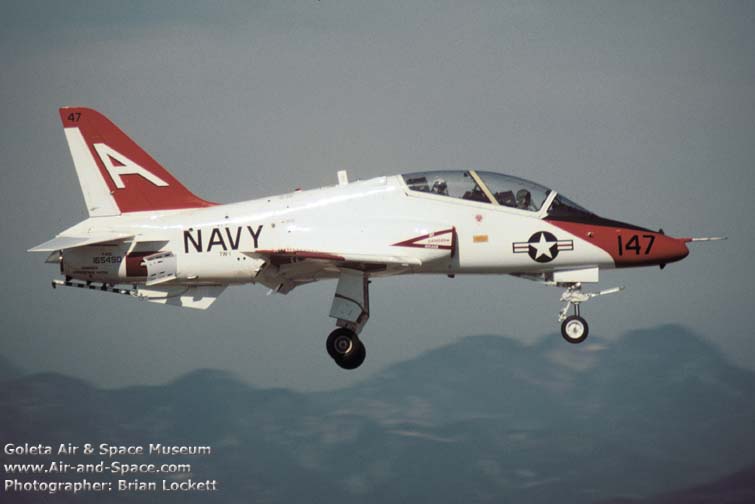As requested by sbst275: The T-45 Goshawk.

The T-45A Goshawk is the US Navy's two-seat advanced jet trainer. The aircraft is jointly manufactured by Boeing and BAE Systems. The T-45A was selected to meet the US Navy requirement for an undergraduate jet pilot trainer to replace the TA-4J Skyhawk and T-2C Buckeye. The TA-4J was retired in 2003 and the T-2 will be retired in September 2004.The T-45A entered service with the US Navy in January 1992. The US Navy and Marine Corps have more than 160 T-45 Goshawks and a total of 234 is planned. The T-45TS pilot training scheme includes advanced simulators and computer assisted instruction as well as training flight programmes.
The T-45A Goshawk is a navalised version of the BAE SYSTEMS Hawk advanced jet trainer, selected by the Royal Air Force and flown by the Red Arrows acrobatic display team. Boeing, in St Louis, acts as prime contractor with responsibility for the manufacture of the forward fuselage and cockpit, overall systems integration, final assembly, flight test and integrated logistic support. BAE SYSTEMS is responsible for manufacture and assembly of the sections aft of the rear cockpit bulkhead, which include the wings, centre and rear fuselage, fin, tailplane, air intake, tailcone, speedbrake, windscreen, canopy and flight controls. BMW Rolls-Royce is responsible for the powerplant and Raytheon for the simulators.
DESIGN
To meet the needs of the US Navy training mission and to ensure aircraft carrier compatibility, several modifications to the basic Hawk airframe were incorporated into the T-45 Goshawk design including: new twin nose-wheel with catapult launch T-bar; nosewheel steering for manoeuvring within the confines of the carrier deck; strengthened airframe and undercarriage for catapult launches; relocated speed brakes; provision of under-fuselage tailhook; revised avionics; and modified cockpit layout for compatibility with frontline US Navy combat aircraft.
COCKPIT
The cockpit is air-conditioned and pressurised by an engine air bleed system. Smiths Industries supply the head-up display (HUD) fitted with a video camera system for post-mission analysis, primary and secondary air data indicators and weapon aiming computer and display.
Cockpit 21 is a new digital cockpit which replaces the analogue cockpit used in earlier T-45A aircraft and improves the US Navy's ability to train pilots for the F/A-18 Hornet, the AV-8B Harrier II and other carrier based aircraft. The first T-45A equipped with Cockpit 21 successfully completed its first flight in October 1997 from Lambert International Airport in St. Louis. T-45 aircraft equipped with Cockpit 21 are designated T-45C. The cockpits are equipped with two monochrome 5in multifunction displays supplied by Elbit, which provide navigation, weapon delivery, aircraft performance and communications data. Martin Baker Mk 14 NACES ejection seats are fitted.
WEAPONS
The aircraft is not armed but has a single pylon installed under each wing for carrying bomb racks, rocket pods or auxiliary fuel tanks. A single baggage pod can also be carried on the single fuselage centreline pylon. A gunsight supplied by CAI Industries is fitted in the rear cockpit.
AVIONICS
The avionics suite includes an attitude heading and reference system (AHRS) designation AN/USN-2, a Rockwell Collins AN/ARN-144 VHF omnidirectional radio range and instrument landing system (VOR/ILS), a Honeywell AN/APN-194 radar altimeter and a Northrop grumman (formerly Litton) LN-100G ring laser gyroscope integrated with a Rockwell Collins global positioning system and Kalman filter.
The communications system consists of a UHF/VHF AN/ARN-182 radio from Rockwell Collins and a Honeywell AN/APX-100 identification, friend or foe system (IFF).
ENGINE
The T-45 Goshawk is powered by a single Rolls Royce navalised Adour Mark 871 twin-spool non-afterburn turbofan engine. The casing has been adapted and strengthened for carrier-borne operations. The engine provides an average thrust of 26kN. The fuel management and gauging system and the engine-mounted sensors are supplied by Smiths Industries.
http://www.naval-technology.com/projects/t45/






















